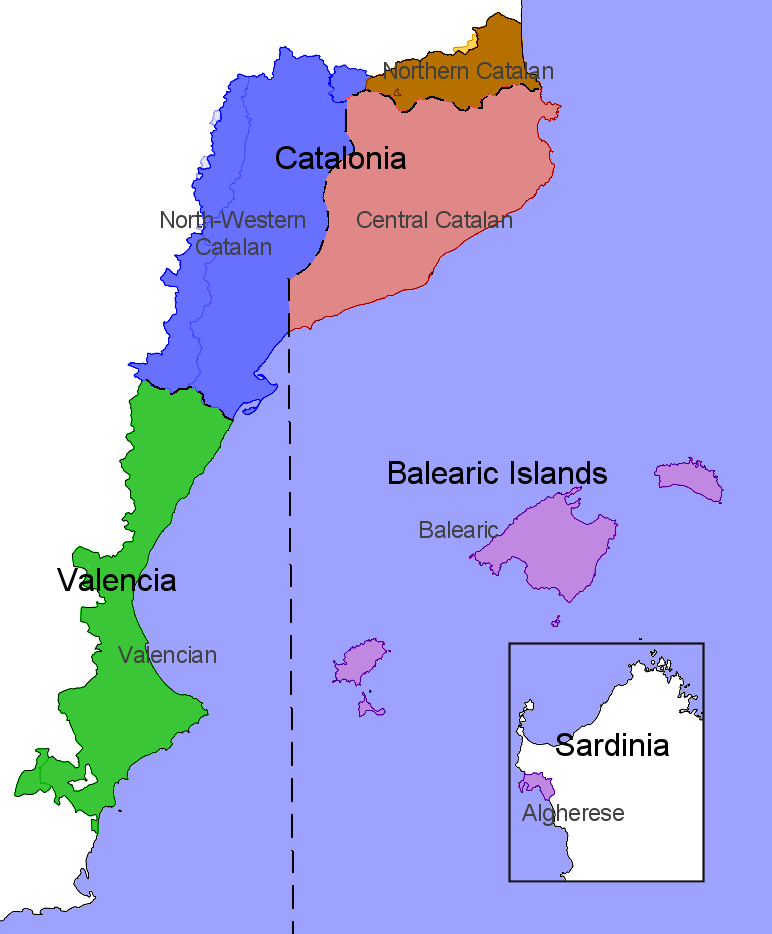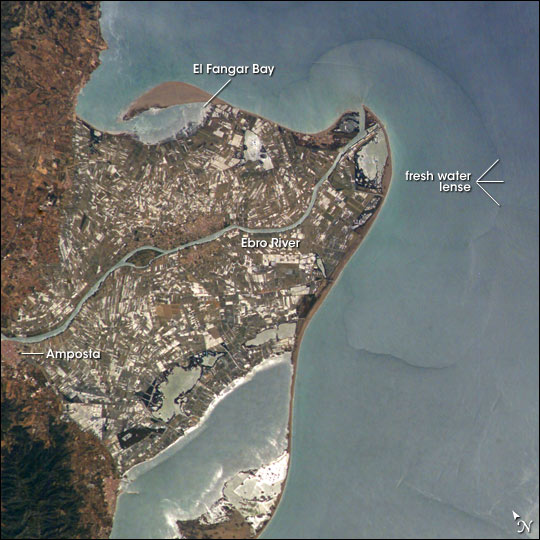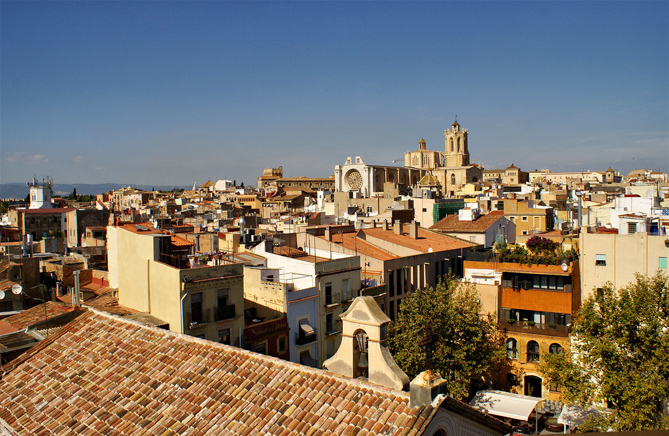|
Tortosa
Tortosa (, ) is the capital of the '' comarca'' of Baix Ebre, in Catalonia, Spain. Tortosa is located at above sea level, by the Ebro river, protected on its northern side by the mountains of the Cardó Massif, of which Buinaca, one of the highest peaks, is located within Tortosa's municipal boundary. Before Tortosa, across the river, rise the massive Ports de Tortosa-Beseit mountains. The area around Mont Caro and other high summits are often covered with snow in the winter. Population centres * Bítem, 1.139; includes Santa Rosa * Campredó, 1.168; * Jesús, 3.755 * Els Reguers, 679 *Tortosa, 27.131 * Vinallop, 363, includes Mianes The municipality includes a small exclave to the west. History Tortosa (from or , via ''Ṭurṭūshah'') is probably identical to the ancient Hibera, capital of Ilercavonia. This may be the ancient settlement the remains of which have been found on the hill named Castillo de la Zuda. In Roman times, the town took the name Dertosa (). To ... [...More Info...] [...Related Items...] OR: [Wikipedia] [Google] [Baidu] |
Ilercavonia
Ilercavonia (, ) is an ancient comarca of Spain formerly populated by the ancient Iberian tribe known as Ilercavones. It is a greater comarca made up of smaller ones. The ties between the people of the region transcend ancient kingdom and later provincial borders. History The name 'Ilercavonia' to refer to the territory occupied by the Ilercavones Iberian tribe appears in ancient Greek and Roman texts and documents. The northern limits of this territory were in Serra de la Llena, the northeastern in Coll de Balaguer, the western in Mequinensa and the southern in the area of a river mentioned as 'Oduba' in Roman documents, which could be either the Millars River, or another river further south along the coast closer to Sagunt. This geographical zone corresponds roughly to the present-day Maestrat/Maestrazgo, Matarraña/Matarranya and Terres de l'Ebre comarcas. During the Middle Ages the territory of Ilercavonia found itself located at the confluence of the kingdoms of ... [...More Info...] [...Related Items...] OR: [Wikipedia] [Google] [Baidu] |
Ports De Tortosa-Beseit
Ports de Tortosa-Beseit (), also known as Ports de Beseit, or simply as Els Ports or Lo Port by locals, is a limestone mountain massif located at the north-eastern end of the Sistema Ibérico, a complex system of mountain ranges and massifs in the centre of the Iberian Peninsula. Its highest point is Mont Caro, 1,441 m. Rivers such as the Matarranya and the Cenia have their source in these mountains. Description At the 1350 m high Tossal dels Tres Reis (Peak of the Three Kings), where the borders of the ancient Kingdoms of Valencia, Catalonia and Aragon meet, there is a cairn marking the meeting point of the ancient three kingdoms of the Crown of Aragon. It is mostly a limestone massif, with many steep cliffs, jagged peaks, deep valleys, shafts and caves. The area is mostly uninhabited except for small villages. These mountains were one of the last redoubts of the Spanish Maquis in the 1940s and 50s. Ecology One of the largest colonies of griffon vultures in Europe, as well ... [...More Info...] [...Related Items...] OR: [Wikipedia] [Google] [Baidu] |
Hibera
Hibera is an ancient city, known for being a strategic point from which the Second Punic War is said to have originated. It was fought over by the Carthaginians and the Romans during this period. According to the texts, most of them from Titus Livius's ''History of Rome'', the city was situated in the north east of the Iberian Peninsula, near the mouth of the Ebro river. After the occupation and rule of both nations the city adopted the name Dertosa. Archeology For a long time nobody had found any trace that this city existed, with its foundations heavily concealed underground. This led to its very existence being disputed. In August 2007, archaeologists brought to light the remains of some of the city walls, dating from the 7th century BC near to the city of Tortosa Tortosa (, ) is the capital of the '' comarca'' of Baix Ebre, in Catalonia, Spain. Tortosa is located at above sea level, by the Ebro river, protected on its northern side by the mountains of the Cardó Massif ... [...More Info...] [...Related Items...] OR: [Wikipedia] [Google] [Baidu] |
Crusades
The Crusades were a series of religious wars initiated, supported, and at times directed by the Papacy during the Middle Ages. The most prominent of these were the campaigns to the Holy Land aimed at reclaiming Jerusalem and its surrounding territories from Muslim rule. Beginning with the First Crusade, which culminated in the Siege of Jerusalem (1099), capture of Jerusalem in 1099, these expeditions spanned centuries and became a central aspect of European political, religious, and military history. In 1095, after a Byzantine request for aid,Helen J. Nicholson, ''The Crusades'', (Greenwood Publishing, 2004), 6. Pope Urban II proclaimed the first expedition at the Council of Clermont. He encouraged military support for List of Byzantine emperors, Byzantine emperor Alexios I Komnenos, AlexiosI Komnenos and called for an armed pilgrimage to Jerusalem. Across all social strata in Western Europe, there was an enthusiastic response. Participants came from all over Europe and had a ... [...More Info...] [...Related Items...] OR: [Wikipedia] [Google] [Baidu] |
Catalonia
Catalonia is an autonomous community of Spain, designated as a ''nationalities and regions of Spain, nationality'' by its Statute of Autonomy of Catalonia of 2006, Statute of Autonomy. Most of its territory (except the Val d'Aran) is situated on the northeast of the Iberian Peninsula, to the south of the Pyrenees mountain range. Catalonia is administratively divided into four Provinces of Spain, provinces or eight Vegueries of Catalonia, ''vegueries'' (regions), which are in turn divided into 43 Comarques of Catalonia, ''comarques''. The capital and largest city, Barcelona, is the second-most populous Municipalities in Spain, municipality in Spain and the fifth-most populous List of metropolitan areas in Europe, urban area in the European Union. > > > ''Catalonia'' theoretically derived. During the Middle Ages, Byzantine Empire, Byzantine chroniclers claimed that ''Catalania'' derives from the local medley of Goths with Alans, initially constituting a ''Goth-Alania''. Othe ... [...More Info...] [...Related Items...] OR: [Wikipedia] [Google] [Baidu] |
Baix Ebre
Baix Ebre (, "Lower Ebro") is a comarca (county) on the coast in southern Catalonia. It is located in the region of Terres de l'Ebre Terres de l'Ebre (, in English 'Ebro, Ebre Lands') is the south-westernmost of the eight regions (Vegueria, ''vegueries'') defined by the Regional Plan of Catalonia. It has a population of 182,231 as of 2022, placing it second to last in terms of ..., and its capital is Tortosa. Municipalities References External linksOfficial comarcal web site (in Catalan) {{coord, 40, 51, 00, N, 0, 33, 19, E, region:ES-CT_type:adm2nd_source:cawiki, display=title [...More Info...] [...Related Items...] OR: [Wikipedia] [Google] [Baidu] |
Mont Caro
Mont Caro () or Caro is the highest mountain of the Ports de Tortosa-Beseit, Catalonia, Spain. Geography It has an elevation of 1,441 metres above sea level.. There are two large Antenna (radio), antennas and a Virgin Mary shrine on top of the summit. This mountain is often covered with snow in the winter. See also *Sistema Ibérico, Iberian System References Mountains of Catalonia Ports de Tortosa-Beseit Emblematic summits of Catalonia Highest points of Spanish provinces {{Catalonia-geo-stub ... [...More Info...] [...Related Items...] OR: [Wikipedia] [Google] [Baidu] |
Cardó Massif
The Cardó Massif (, ; ), also known as Cardó-Boix Massif, is a mountain massif in the Baix Ebre comarca, in Catalonia, Spain. This massif is composed of a number of mountain ranges located on the left side of the Ebro river near Tortosa. The massive calcareous cliffs of the Serra de Cardó form the eastern side of the spectacular gorges through which the Ebro River winds its way in the final stage of its course, separating the Ebro Valley from the Mediterranean coastal area. The ranges cover an area of over 340 km2, extending from Rasquera in the north, to Benifallet in the south and eastwards through El Perelló until reaching the Mediterranean Sea between L'Ampolla and L'Ametlla de Mar. Highway N-340 crosses the eastern side of the massif and Autopista AP-7 skirts the easternmost foothills by the seashore. All the ranges are part of the Catalan Pre-Coastal Range. The main peak is Xàquera, also known as ''La Creu de Santos'' (942 m) in the Serra de Cardó, another i ... [...More Info...] [...Related Items...] OR: [Wikipedia] [Google] [Baidu] |
Northwestern Catalan
The Catalan dialects (and restrictively also, Valencian dialects) feature a relative uniformity, especially when compared to other Romance languages; both in terms of vocabulary, semantics, syntax, morphology, and phonology. Mutual intelligibility between its dialects is very high, estimates ranging from 90% to 95%.R. A. Hall, Jr. (1989), cited oEthnologue (archived)/ref> The only exception is the isolated idiosyncratic Alguerese dialect. Geographic classifications Overview of main varieties and areas Western vs. Eastern In 1861, linguist Manuel Milà i Fontanals split Catalan into two main dialectal blocks: Western and Eastern. The most obvious phonetic difference lies in the treatment of unstressed a and e, which have merged to in Eastern dialects, but remain distinct as and in Western dialects. There are a few other differences in pronunciation, verbal morphology, and vocabulary. Western Catalan comprises the two varieties of North-Western Catalan and Valencian ... [...More Info...] [...Related Items...] OR: [Wikipedia] [Google] [Baidu] |
Ebro
The Ebro (Spanish and Basque ; , , ) is a river of the north and northeast of the Iberian Peninsula, in Spain. It rises in Cantabria and flows , almost entirely in an east-southeast direction. It flows into the Mediterranean Sea, forming a delta in the Terres de l'Ebre region, in southern Catalonia. In the Iberian peninsula, it ranks second in length after the Tagus and second in discharge volume, and drainage basin, after the Douro. It is the longest river entirely within Spain; the other two mentioned flow into Portugal. The Ebro flows through many cities (): Reinosa in Cantabria; Frías and Miranda de Ebro in Castile and León; Haro, Logroño, Calahorra, and Alfaro in La Rioja; Tudela in Navarre; Alagón, Utebo, and Zaragoza in Aragon; and Flix, Móra d'Ebre, Benifallet, Tivenys, Xerta, Aldover, Tortosa, and Amposta in the province of Tarragona (Catalonia). Geography Upper part and tributaries The source of the river Ebro is in the Cantabrian Moun ... [...More Info...] [...Related Items...] OR: [Wikipedia] [Google] [Baidu] |
Province Of Tarragona
Tarragona (; ) is a province of eastern Spain, in the southern part of the autonomous community of Catalonia. It is bordered by the provinces of Castellón, Teruel, Zaragoza, Lleida and Barcelona and by the Mediterranean Sea. The province's population is 795,902 (2018), about one fifth of whom live in the capital, Tarragona. Some of the larger cities and towns in Tarragona province include Reus, Salou, El Vendrell, Tortosa, Valls, Amposta. This province has 183 municipalities. The province includes several World Heritage Sites and is a popular tourist destination. There are Roman Catholic cathedrals in Tarragona and Tortosa. History After the Umayyad conquest of Hispania in the late eighth century, this part of Spain came under the control of the Umayyad Caliphate and most of the Iberian peninsula was known as Al-Andalus, and was dominated by Muslim rulers. Abd al-Rahman I founded an independent dynasty that survived in the region until the 11th century. After the Musl ... [...More Info...] [...Related Items...] OR: [Wikipedia] [Google] [Baidu] |
Comarques Of Catalonia
The comarques of Catalonia (singular ''comarca'', , ), often referred to in English as counties, are an Subdivisions of Catalonia, administrative division of Catalonia. Each comarca comprises a number of municipalities of Catalonia, municipalities, roughly equivalent to a Counties of the United States, county in the United States. Currently, Catalonia is divided into 42 comarques and Val d'Aran, Aran, considered a "unique territorial entity" and not a comarca. Each comarca has a representative comarcal council, county council (), except for Barcelonès, which abolished it in 2019, and Aran, which instead has the Conselh Generau d'Aran. Comarques form the second-level administrative division within Catalonia, being a subdivision of Vegueries of Catalonia, vegueries (or Provinces of Spain, provinces at state level). Comarques of Catalonia Overview Although today the comarques are officially defined under a Catalan parliamentar ... [...More Info...] [...Related Items...] OR: [Wikipedia] [Google] [Baidu] |



